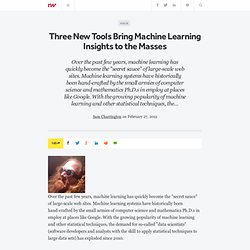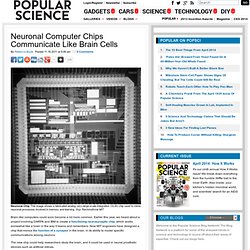

Three New Tools Bring Machine Learning Insights to the Masses. Over the past few years, machine learning has quickly become the "secret sauce" of large-scale web sites.

Machine learning systems have historically been hand-crafted by the small armies of computer science and mathematics Ph.D.s in employ at places like Google. With the growing popularity of machine learning and other statistical techniques, the demand for so-called "data scientists" (software developers and analysts with the skill to apply statistical techniques to large data sets) has exploded since 2010. As a result, these rarefied skills have become extremely difficult to find and expensive to retain, driving up the cost of machine learning systems and making it difficult for enterprises and smaller web firms to apply the technology.
In the data scientist talent shortage is opportunity, however, and a new breed of software platform is rising to meet this need. Skytree This is not to diminish the Skytree value proposition in the least. BigML BigML Precog. Bottlenose 2.0 Is a 6th Sense for the Social Web. I just received surprise news that Bottlenose hit version 2.0.

It's an intelligent social dashboard, but don't think "another social dashboard. " Here's the breakdown: If you think in customers, use Nimble. If you think in interpersonal connections, use Engag.io. But if you want a social dashboard for ideas, that's what Bottlenose is for. I'll give it to you straight. Bottlenose is named after a dolphin for a reason. There's a lot going on under the hood of Bottlenose. It does all this at the browser level. Bottlenose refreshes itself with new info, and it keeps you notified in granular ways of what's new. Photos, videos and articles can now be expanded for view within the stream. HOW TO: Block Google (And Everybody) From Tracking Which Sites You Visit On Your iPhone. 5 low-profile startups that could change the face of big data — Cloud Computing News.
Luis von Ahn: Massive-scale online collaboration. Image-Recognition Algorithm Diagnoses Breast Cancer Better Than a Human Doctor Can. Add one more item to the list of things machines can do better than humans: Examine and diagnose breast cancer.

Stanford researchers have developed new software that can automatically evaluate microscopic images of breast cancer and make determinations about its aggressiveness and type, offering patients an accurate prognosis. It's more accurate than a human doctor, as it turns out. The system brings cancer pathology, which has largely been unchanged since the Great Depression, firmly into the 21st century.
The new system is called C-Path, for Computational Pathologist. It can classify the types of cancer cells present, and even identified a new set of features that are associated with a poor chance of survival, according to its developers. Stanford researchers led by Dr. Once it was trained, Beck et al. used C-Path to evaluate tissues of cancer patients it had not examined before. Despite this success, C-Path is still a long way from clinical use, the authors say.
Neuronal Computer Chips Communicate Like Brain Cells. Brain-like computers could soon become a lot more common.

Earlier this year, we heard about a project involving DARPA and IBM to create a functioning neurosynaptic chip, which works somewhat like a brain in the way it learns and remembers. Now MIT engineers have designed a chip that mimics the function of a synapse in the brain, in its ability to model specific communications among neurons. The new chip could help researchers study the brain, and it could be used in neural prosthetic devices such as artificial retinas. The MIT chip has 400 transistors, which together can emulate the activity of a single brain synapse. A synapse is the gap between neurons that enables the release and binding of neurotransmitters to and from dendrites. The new chip works by mimicking the action of these ion channels, according to MIT News.
The researchers say this chip is the first to demonstrate capability in spike-rate-dependent plasticity and and spike-timing-dependent plasticity.